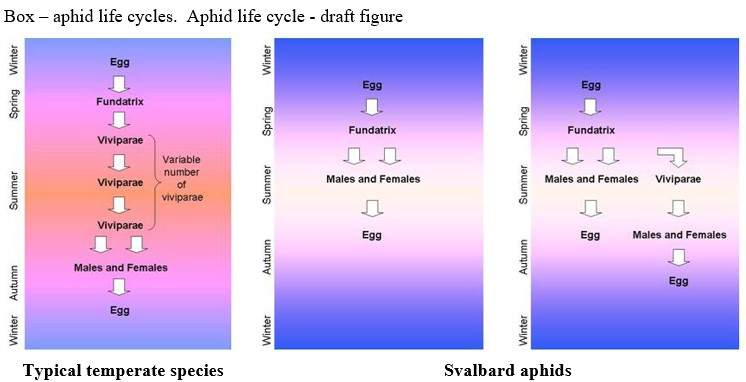Arctic regions are characterized by long cold winters and short cool summers. In order to establish invertebrates require more than to be able to tolerate the cold winter, they must also be able to grow and reproduce during the cool summer.
Many species have extended life histories where they grow a little during each summer until finally adult. This strategy is common amongst soil invertebrates where animals such as the soil oribatid mites might take five years to become adult. A species of moth in Greenland requires at least seven years as a larvae before it has grown sufficiently big to pupate and if the summers are poor it might require twice as along.
Other species have a short life cycle and can only overwinter as an egg for example the fairy shrimp, Lepidurus arcticus. Another example with a delicately tailored life history to the Arctic environment are the two endemic aphids, Sitobion calvulus and Acyrthosiphon svalbardicum. To understand how the Arctic aphids have adjusted their life cycles to suit Svalbard it is first necessary to understand the life cycle of the proginators of these aphids; the temperate aphids.
Aphids have two basic strategies; they are either holocyclic or anholocyclic. During the warm summer months the aphids are parthenogentic viviparae, that is to say they are all females all giving birth to more females without the need to mating. Anholocyclic clones overwinter as these adult females but in northern European regions require a mild winter to survive. Adult aphids are generally not greatly cold tolerant. After mild winters these females begin to produce young as soon as temperatures rise the following spring and give rise to the aphid outbreaks known well to all gardeners. However, during colder winters it is only the egg that can survive. Clones overwintering via an egg are known as holocyclic. These clones produce eggs in the autumn and will hatch the following summer. Due to the time lag required for these eggs to hatch and for the young to mature, the build-up in the aphid populations is delayed in years following a cold winter. Production of these eggs in the autumn is dependent on environmental cues, often the change in day length. The aphid detects the shortening days of autumn and instead of producing more viviparae, the offspring are sexual males and females which mate and produce the overwintering eggs.
In the Arctic the aphids have a problem. They cannot overwinter as adults. Nonetheless they cannot wait to produce sexual offspring until day length starts to change as by that time there is not enough summer remaining for this generation to mature and produce eggs before the winter arrives. The solution is to develop a genetically programmed lifecycle that is independent of the environment. The aphid Sitobion calvulus is found in areas in Adventdalen and is one of the worlds most restricted insect species being limited to a very few localities on Svalbard (Gillespie et al 2007). The lifecycle of this aphid is as short as it can be. From the egg a morph known as a fundatrix hatches and this produces a mixture of males and sexual females from which the overwintering eggs are produced. Very few aphids produce sexual morphs from the fundatrix and this is believed to be an adaptation to the short Arctic summer. Note that no environmental cues are involved but that the aphid has minimalistic life cycle guaranteed to produce eggs before the onset of winter. While this life cycle is well suited to Arctic regions, the ability to rapidly build up a population is limited. The number of eggs produced by the offspring from one egg is small and aphids on Svalbard have not only to survive the climate but also avoid a range of predators and parasitoids. The other endemic aphid, A. svalbardicum therefore has a strategy that ensures egg production every year but which also can boost the number of eggs produced (Strathdee & Bale 1996). This aphid also has a life cycle similar to that of S. calvulus but has a second pathway. A few of the offspring of the fundatrix are not males or sexual females but are viviparous females as in temperature aphids. The offspring of these adults are always males and sexual females. This extra generation usually fails to produce eggs as the extra time required for the viviparae to mature before producing males and sexual females means that the winter arrives before the eggs are laid. Why then have this extra generation? The answer seems to be that by sacrificing a few adults in most years, in years where the viviparous generation succeeds to lay eggs the total egg production can be greatly enhanced. Making some basic assumptions and assuming no mortality it can be shown that in a year with a long summer the extra generation increases egg production several fold. Further, that this generation need only succeed once every 26 years for it to be evolutionarily advantageous to the aphid.







